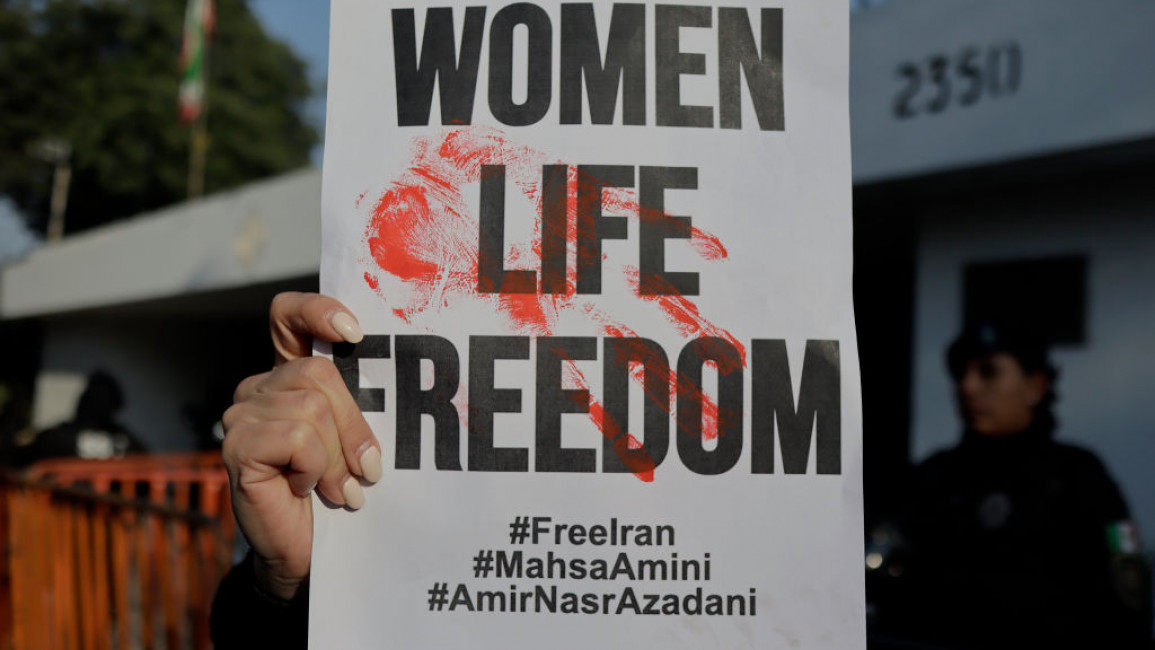
This Women's History Month, remember the struggle continues for Iran's indomitable women
Nearly four months of violent crackdown on the nationwide uprisings in Iran has left the nation with scars that it is struggling to recover from. Theoretically, nothing has changed. The same government that refused to acknowledge the demands of the protesters and responded to them with an iron fist, remains in power. Moreover, the situation is spiralling into further uncertainty as the national currency has hit rock bottom amid hyperinflation.
In practice, some Iranians are cautiously enjoying some of the basic freedoms they believe they have claimed piecemeal, ones that the government never recognised and continues to disavow.
It is possible to see women on the streets of Tehran, Isfahan, Rasht, Shiraz and Tabriz walking around the town, shopping or dining out without a headscarf. Whilst this may seem trivial, it was inconceivable before the protests following the killing by the morality of 22-year-old Mahsa Amini who was arrested for wearing a headscarf loosely.
''These unending standoffs over the hijab compliance have a predictable consequence: they yield pent-up anger and widen the gaps in an already divided society that is finding it increasingly difficult to find a path towards dialogue.''
If smiles are missing from the faces of many of the women who have discarded the compulsory hijab, it is because they’ve witnessed traumatising scenes of clampdowns on the streets during protests. Many others are also likely to know people who have lost a loved ones or been detained at some point.
As such, even their newfound liberty against a backdrop of patriarchal state practices, is not deemed an achievement to celebrate as long as wounds endure and hearts remain broken. But a government that sowed wind through its persistent evangelism around the imperative of compulsory hijab and consequently eventually faced mass public anger has clearly not learned from its failed policies.
Quite the opposite, although seeking to shove religion down people’s throat over the past four decades clearly backfired and was rejected in a sweeping protest movement, there are indications the government is renewing the agitprop on this social fault line. As the protests abate, life reverts to normal and women who ditch their hijab are being met with the might of the state’s security apparatus and street vigilantes, a cohort of powerful institutions are brandishing new counter plans to punish hijab violations.
The spokesperson for the Initiative for the Promotion of Virtue and the Prevention of Vice, Ali Khanmohammadi, stated that parliament is considering legislation that is aimed at invalidating the national ID cards of the women who don't observe the hijab, and the “offenders” will be denied public services for a one-month period.
He additionally announced that surveillance of shopping centres will be beefed up, and 32 institutions will be engaged in publicity and raising awareness on the importance of hijab.
Khanmohammadi, a hardline cleric, also told the media that new mechanisms are being pondered to replace the morality police, which was allegedly abolished, saying there should be vehicles patrolling the streets to take action against people who appear in public “inappropriately” dressed. He emphasised that failure to observe the hijab is an infringement of law, and that there should be a legal response to any such violation.
He vehemently denied the possibility of a referendum on the enforcement of compulsory hijab, intoning if every social matter is up for referendum, the outcome would be anarchy.
Kazem Sedighi, the influential preacher of Tehran, also said in recent remarks that “the violation of hijab should be contained now that the situation has become calmer,” referring to the slowing down of the protests. He said hijab is a social obligation and those who remove the veil are “ignorant.”
Warnings from judicial authorities against the women who don’t comply with the mandate have become much more vociferous, and a number of shopping centres and pharmacies have been closed down over their staff or customers not donning a headscarf.
As the experience of the past four decades corroborates, culminating in the ‘Woman, Life, Freedom’ movement, this repressive approach works against the clerical establishment and fuels discontent towards it.
It is not imminently clear if there is a consensus at the top leadership brass over rekindling the compulsory hijab given the magnitude of violence and intransigence people witnessed against the demonstrations. But even if there is a division over accepting the status quo and letting women have minimal leeway, or leveraging a combination of force and legislation to strangle the social space further, those who are advocating for the latter are either too fundamentalist in their ideology or too short-sighted.
It is no longer possible to peddle propaganda on compulsory hijab in a society that doesn’t believe the enforcement has anything to do with religious concerns. The clerics who issue threats to women defying the headscarf codes and vow legal action are not espousing the tenets of any religion. In fact, they are doing to the public portrayal of Islam a huge disservice.
Zeinab Kazempour, a civil engineer in Tehran, was planning to run in the elections of the board of directors of the Tehran Construction Engineering Organization. She was barred from running over the allegations that she had ignored the hijab codes. During the voting session, held in a large auditorium, she went on the stage and spoke up about her refusal to lend legitimacy to an institution that discriminates against its members over their dressing. She then threw away her headscarf amid an outburst of applause and left the hall.
Local media reported that legal proceedings have been initiated against her.
These unending standoffs over the hijab compliance have a predictable consequence: they yield pent-up anger and widen the gaps in an already divided society that is finding it increasingly difficult to find a path towards dialogue.
Different strata of the Iranian society and the government are hard-pressed to understand each other. In the middle of all of this, the power-wielding elites are making a bad situation worse by starting to tread the same abysmal path that has led to the current stalemate.
George Santayana, the Spanish-American philosopher famously said, “those who cannot remember the past are condemned to repeat it.” It is implausible that the Iranian authorities don’t remember what has happened over the past months and the resentment that engulfed the country in the lead up. But, they appear to be pretending that nothing has gone on, or that what has unfolded was not substantial. Such an approach is likely to lead to further protests, maybe even more widespread than before.
Kourosh Ziabari is an award-winning Iranian journalist and reporter. He is the Iran correspondent of Fair Observer and Asia Times. He is the recipient of a Chevening Award from the UK's Foreign and Commonwealth Office and an American Middle Eastern Network for Dialogue at Stanford Fellowship.
Follow him on Twitter: @KZiabari
Have questions or comments? Email us at: editorial-english@newarab.com
Opinions expressed here are the author's own, and do not necessarily reflect those of her employer, or of The New Arab and its editorial board or staff.




